TI's 10G optical module SFP+ total solution is a complete demodulation demonstration working optical transceiver solution for small plugs (SFP+).
This solution reduces customer design time and saves customer costs without sacrificing performance. This is achieved by combining TI's laser driver ONET1101, limiting amplifier ONET8501 and powerful MCU MSP430 into one SFP+ multi-source protocol standard package. In addition, the article will show you convincing design documentation and test results.
This application note introduces you to schematics, PC board layouts, Gerber files, bill of materials (BOM), firmware, and graphical user interfaces (GUIs); not only for modularity, but also for evaluation boards. This solution also describes the test setup, test data, and typical performance of the assembled circuit board.
introduction
The Enhanced Mini Plug (SFP+) is a compact, hot-swappable transceiver for 10G telecom and datacom applications. This is a popular industrial format developed and supported by many system component vendors. Both form factor and electrical interface are specified by a Multi-Source Agreement (MSA).
With a complete line of laser drivers, limiting amplifier optical transceivers, and TI's powerful MCUs, TI is able to offer customers a complete range of SFP+ design solutions. We chose ONET1101 11.3G laser driver, ONET8501, limiting amplifier, MSP430, MCU for this 10G SFP+.
This application note covers 10km 10G DML basic SFP+ design details and test solutions: including module side schematics, PCB layout, firmware, BOM, debugging skills; also includes evaluation board schematics, PCB layout, GUI, BOM and test results .
SFP+ module diagram
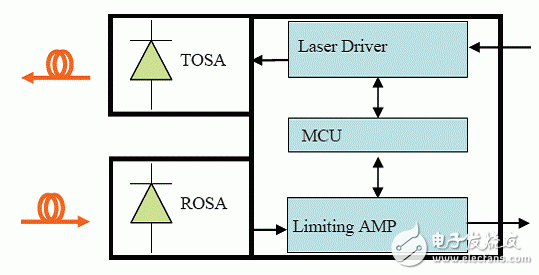
The SFP+ includes a transceiver (laser driver ONET1101+DML NEC NX8341), a receiver (ROSA+ limiting amplifier ONET8501) and a control module (MCU MSP430FR5738).
Transmitter
The transmitter converts the electrical signal into an optical signal.
The laser driver ONET1101 amplifies the input signal into a modulated signal and provides a biased DC current to the DML.
The ONET1101L is a high speed, 3.3V laser driver for direct modulation of lasers at data rates from 2 to 11.3 Gbps.
3.1 Transmitter schematic:
The ONET1101L has a two-wire serial interface that helps digitally control modulation with biasing and crossover points, eliminating the need for external components. The ONET1101L also has an integrated automatic power control (APC) loop and circuitry to support laser safety and transceiver management systems.
Utilizing digital control interface capabilities, the ONET1101L allows designers to focus on high-speed paths and impedance matching for optimal performance.
The following schematic shows the optimal impedance structure for a typical DML.
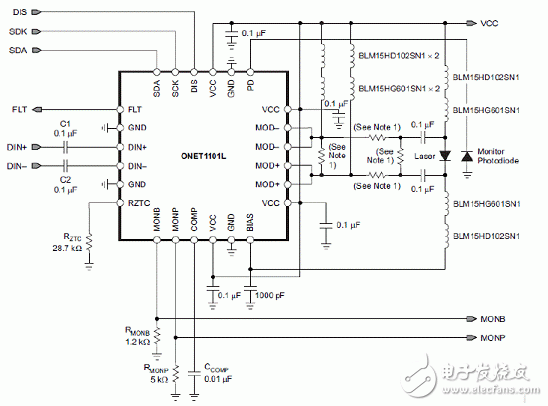
3.2 PCB layout
A distributed feedback (DFB) laser is a low resistance component that is typically 7 to 10 Ω.
Flexible PCB cables are often a 25? single-ended line
There is reflection between the flexible cable and the TOSA.
Careful layout and impedance matching circuits are critical to achieving higher performance.
This solution has a demo work layout as follows:
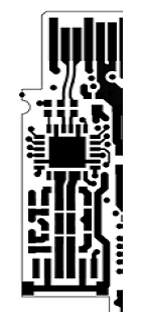
3.3 Calculation method
The ONET1101L laser diode driver is optimized to drive a 50? differential output transfer impedance.
In low-power design, it has a 500? differential back-end. Since the LR DFB TOSA has only 10? impedance (approximation), it is even worse if no transmission circuit is added. The role of the transmission circuit is to drive the load impedance close to 50? from the driver end.
Output impedance: The differential resistance of the MOD± output is:

The typical RTOSA is about 10?, and the optimized R1~R4 are:

Then ZOUT is:

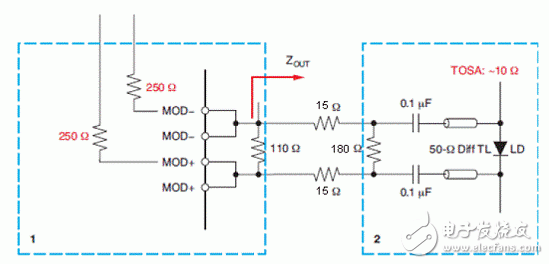
3.4 Test results
TOSA: NEC NX8431
VCC=3.12V
ICC=150mA
Room temperature
10.3G PRBS31
Eye template margin margin 30%

Bluetooth Hat Headphones are a combination of fashion and technology, so you can listen to music without wearing extra headphones. Bluetooth Stereo Headphones bring you sound quality, style and comfort.The latest Blutooth V5.0 technology: Easily and quickly work with mobile phones, tablets and other Bluetooth music devices, with a wireless range up to 33 feet. To answer and hang up calls, you can operate directly on your hat without using your phone. Built-in rechargeable lithium-ion battery, about 6 hours of call/play time, 2.5 hours of charging time, 60 hours of standby time, so you have less charging time and more working time. The hat can be completely washed after taking off the headphones.
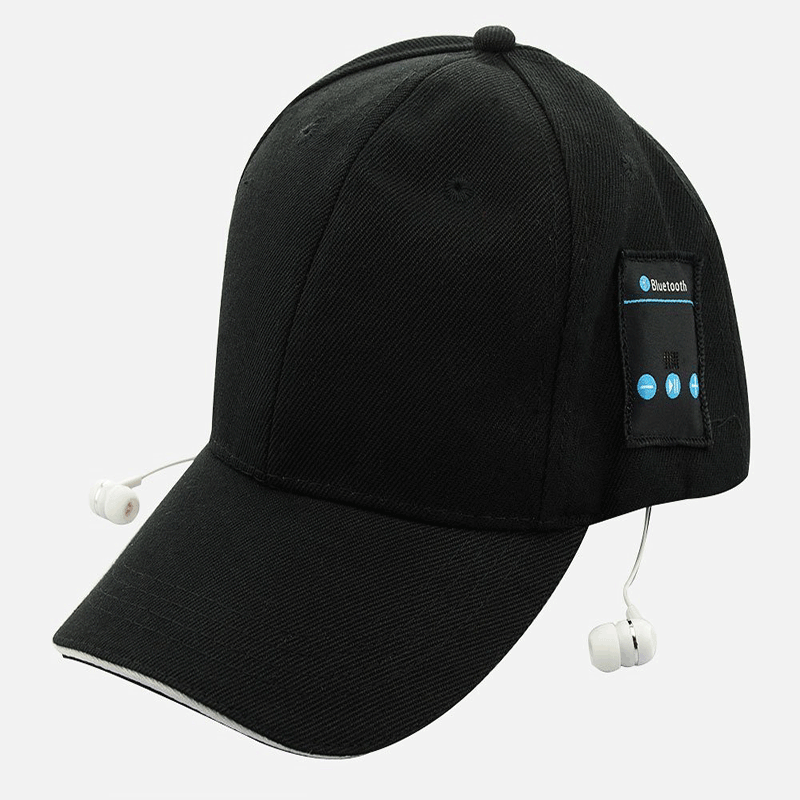
Bluetooth Hat Headphones
Wireless Bluetooth Headset,Bluetooth Earphone,Bluetooth Hat Headphones,Winter Hat With Bluetooth Headphones
Shenzhen Linx Technology Co., Ltd. , https://www.linxheadphone.com